The area in and around East Cannock
Road has a rich and varied history.
Over the years a colliery, a stables
and a busy canal basin were all
situated nearby.
The canal house
Tom Pearce, the canal toll-keeper, lived at
the canal house with his wife Annie and
their eleven children. It was built for him in
1905, at the site his wife chose.
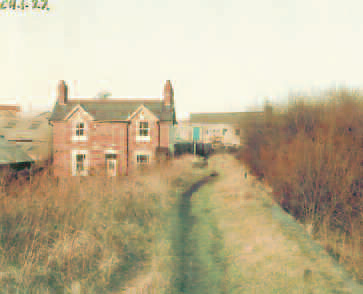
The canal toll-keeper’s house
One of Tom’s grand-daughters remembers:
My grandfather’s job came with a house,
which Birmingham Canal Navigation built
for him… They were allowed to choose
exactly where they wanted the house to be
sited. My grandmother chose a spot a few
yards from the cottage near to the railway
bridge arches so that she could look through
them and watch her children as they
walked down the road to school.

Tom and Annie Pearce
Tom and Annie lived in the house until Tom
retired in the mid 1930s. In the 1960s the
house was demolished when the canal was
drained.

Annie Pearce, aged 32
|
The canal and its basin
The Cannock extension of the Wyrley and
Essington Canal terminated here at a large
canal basin across the road. It was
completed in 1863, at the close of the canalbuilding
era, and was abandoned in 1963. It
is said that there were once so many barges
leaving the basin that at noon each day they
created a small bore (a sort of tidal wave),
which ran the length of the canal.

Hednesford canal c1920
A tramway that became a railway brought
coal to the three wharfs, where it was
loaded into barges delivering to the Black
Country. When horses pulled the barges they
were stabled opposite the Globe Inn.

|
In 1846 the Incorporated Seamen
and Boatmen’s Friend Society was
founded. It aimed to help improve
the spiritual and physical lives of
men and women working at sea
and on canals, and had three
Mission Halls in the Midlands. One
was established in 1885, here at
the Hednesford canal basin, where
according to the 1871 Census there
were around 56 people living on
18 boats.
A Mission at Hednesford had been proposed
in 1883. It was to offer a suitable coffee and
reading room, well supplied with local papers – where men and their wives may spend an
enjoyable evening, and a comfortable Mission
and schoolroom, where our friends may hear
of Heaven and learn the Way.
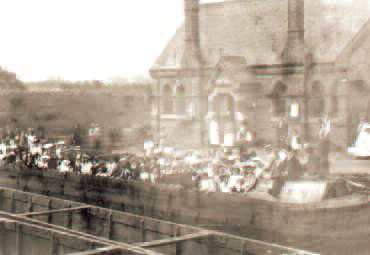
The Boatmen’s Mission c1910
The Mission opened in July 1885. Its staff
served drinks and food and sold basic
provisions. They helped illiterate boatmen by
writing letters for them, and offered religious
meetings, lectures and services.
|

This photograph was taken at the Boatmen’s Mission
in the 1950s.
Pictured are Rose Deavall’s sister Edna
(on the left) with
Edna’s daughter Veronica and their
horse, Tommy.
The majority of the information about the Boatmen’s
Mission has been kindly provided by Anthony Hunt.
|
East Cannock Colliery
East Cannock Colliery was situated near the Globe Inn, in the area that now borders Stagborough Way. Full production began in 1876, two years after the
completion of two shafts. The ambitious plan to mine here at a cost of £120,000 had been made by a group of businessmen. The company chairman named one of the shafts Amy, after his daughter Amy Stokes.
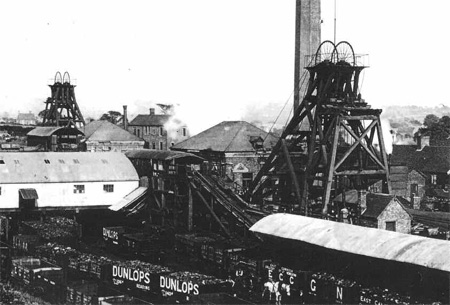
East Cannock Colliery c1880
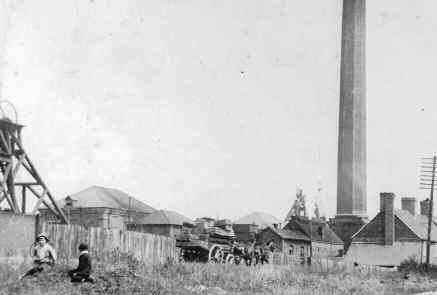
East Cannock Colliery, probably in the early 20th century
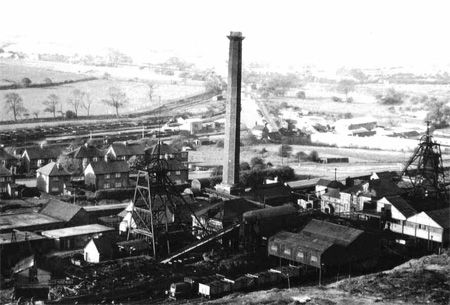
East Cannock Colliery c1950. The canal basin is shown in the background, to the right of the chimney
|
Tragedy struck the colliery in 1877 when an explosion of methane killed four boys and four horses and seriously injured two men.
For their injuries each workman received £10 10s, while the owner of one of the horses was awarded£15 15s.
By 1880 the business had failed and the company went into liquidation. It was sold for just £20,000, to Henry Davis Pochin, a Welsh businessman.
In 1947 the colliery was taken over by the National Coal Board, but ten years later it had closed due to lack of reserves. Surrounding collieries took the remaining coal and redeployed some of East Cannock Colliery’s workers.
The Globe Inn
As the coal mining industry grew in the 1800s the population of Hednesford swelled, and public houses began to cater for the workmen.
The original Globe Inn, which had two storeys, was established by Thomas Brindley in 1870. In 1946 the upper storey was removed when mining subsidence had weakened the building.
The majority of the information about the Globe Inn has been kindly provided by Anthony Hunt.
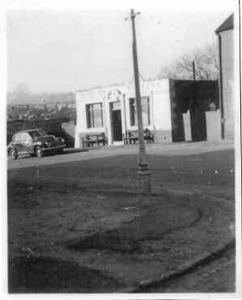
The original Globe Inn in the 1950s
|
Opposite the Globe Inn was the Red House. The building was originally a racing stables. In later years it became the home of a former music hall star.
The racing stables were run by a man named Lawrence Rooney. There were once at least six racing stables in the Hednesford area, but by the early 1900s the Red House was one of only three that remained. Erskine Williams (on the right). He is pictured with his pals at one of the military training camps on Cannock Chase, where he served during the Great War. In later life he resided for a while at the Red House.
The Williams family at the Red House
As a child in the 1890s, Erskine Williams became famous on the Victorian music hall scene as Little Erskine, the child ‘lightning cartoonist’ who toured the UK and around the globe.
In 1942 the Red House became the premises of the Artistic Poster Company, run by Erskine’s brother Frank, who owned the Tivoli and Empire cinemas in Hednesford. Erskine became an artist for his brother, and lived at the house with his wife Violet and their two children.
Their daughter Daphne tells us how the Red House seemed to her as a child:
I remember it as a rather creepy house – even in the summer the wind howled
through the ill-fitting top floor windows. It was built over the local mine and the wall of our living room had a huge crack right across it that you could see through.
|
 Erskine Williams (on the right). He is pictured
Erskine Williams (on the right). He is pictured
with his pals at one of the military training
camps on Cannock Chase, where he served
during the Great War. In later life he resided
for a while at the Red House |












